Rediscovering my backyard along the Cardiff Bay Trail
Rediscovering my backyard along the Cardiff Bay Trail
Written by Dr Rhoda Ballinger, SEP Chair
From engineering innovations and maritime heritage to wildlife and national landmarks, I discover some of the current attractions of the Bay and reflects on the urban development process which transformed Tiger Bay into a vibrant waterfront.
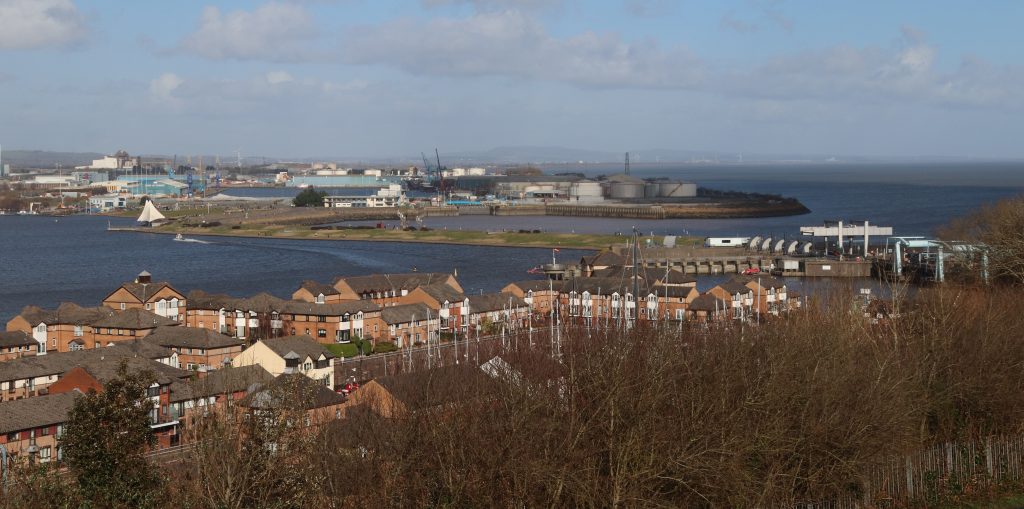
Cardiff Barrage from Penarth
Introduction
Having visited a couple of other waterfront developments on my recent Severn walks, I decided it was about time I did a walk along my local waterfront, Cardiff Bay. Having been along this popular section of the Wales Coast Path countless times before, I thought this might be an easy win, given my busy schedule this month. Having taken days to edit my extensive collection of photos of the Bay, I’m not so sure about that now. Anyway, I hope you enjoy reading my article and if you’ve not been to ‘the Bay’ before I hope it will inspire you to come over to Cardiff and sample its many attractions. As with previous articles, I’m delighted that I have had other contributions to add to my ramblings. This month thanks go to David Hall from the Cardiff Bay Harbour Authority and to Nerys Lloyd-Pierce, Chair of the Cardiff Civic Society, for their comments and thoughtful insights.
The barrage and links to the estuary
Under a steel grey sky with only the slightest hint of a watery sun, I embarked on my walk, starting at the Barrage. The sheer scale of this engineering masterpiece never ceases to impress. It certainly needs to be a mighty structure though, impounding both the Ely and Taff, as well as keeping out the estuary’s waters from the 200 ha freshwater lake behind. At just over a kilometre long and with multiple locks, five sluice gates and a fish pass, there’s lots to see. On today’s visit I had the good fortune, or rather I’d planned, to see the barrage operating at both high and low water, so I could appreciate the strength of this structure against the scale of our estuary tides. As you’ll see from my photos it was quite a different seascape at these extremes, even though these weren’t particularly large tides within our tidal cycle.
The barrage was built to create an ‘aesthetically attractive’ waterfront to drive urban regeneration and revive Cardiff’s old dockland areas. It does however, play another key function now, providing some protection from upstream flooding. Each sluice gate can release staggering amounts of water, so if there’s a storm forecast, water can be released into the estuary to make room for further river flows. Even on my visit today, the most westerly sluice gate was open, and water was flowing swiftly out to sea.
Water was also swirling around in the fish pass at the end of barrage. This Denil Pass, which was the largest fish pass in Europe when it was constructed, includes a series of pools and weirs for the migratory fish to negotiate. Looking down at the swirling waters of the fish pass at low water, I’ve always hoped one day I might see some leaping salmon or sea trout, but February is out of season unfortunately. Anyway, I hope the many fishermen who’d set up camp at the end of the outer breakwater of the Barrage would be more fortunate in their catch, particularly given they were sitting out for hours in bitingly cold temperatures
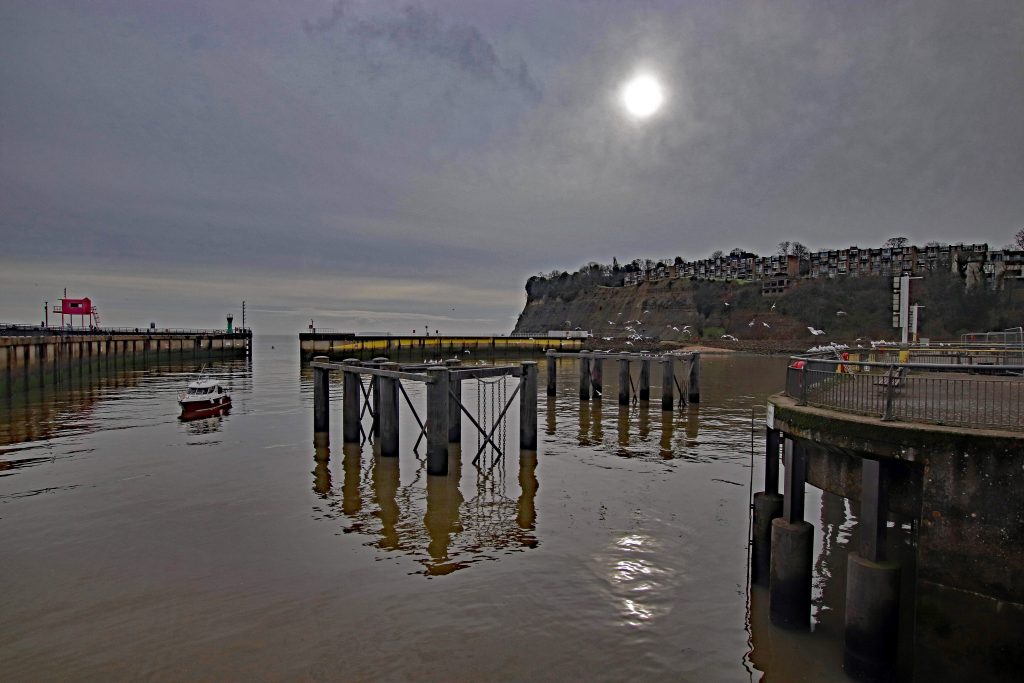
The harbour offshore Cardiff Bay at high water
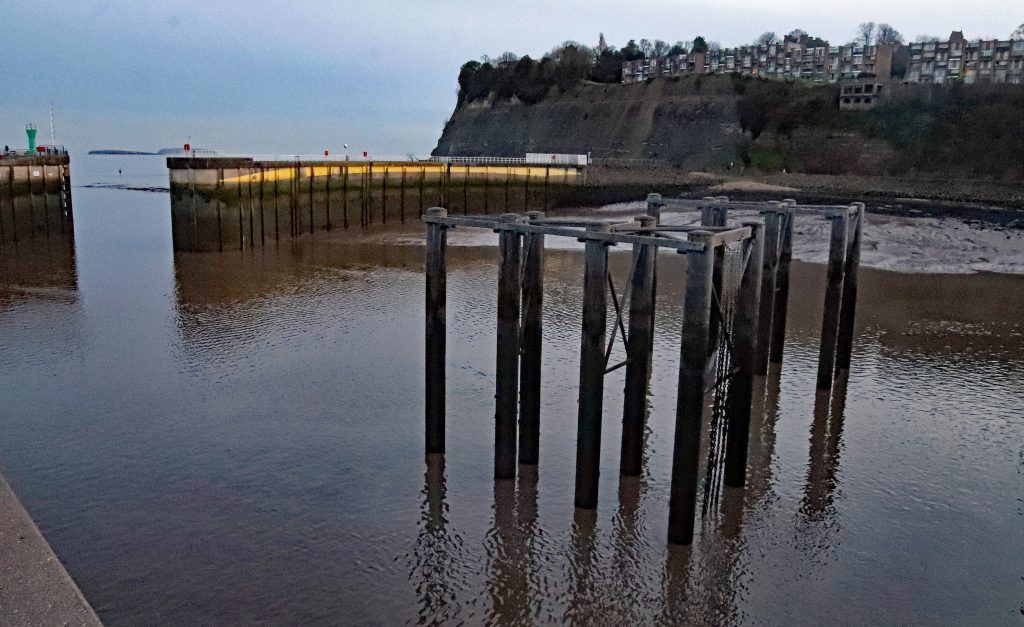
The harbour offshore Cardiff Bay at low water
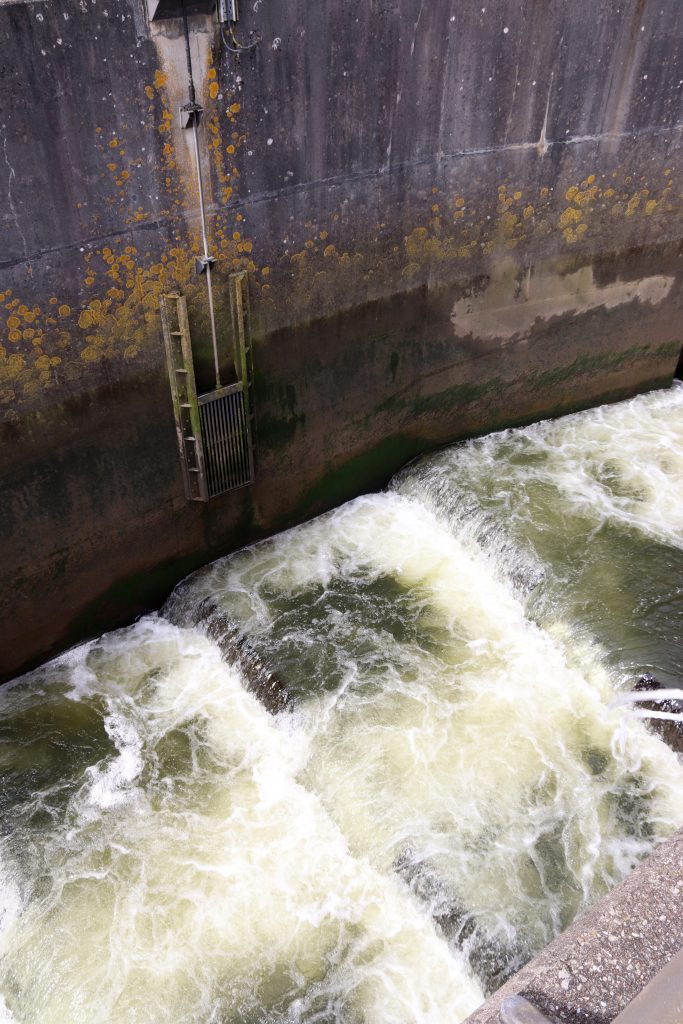
The swirling waters of the fish pass at low water
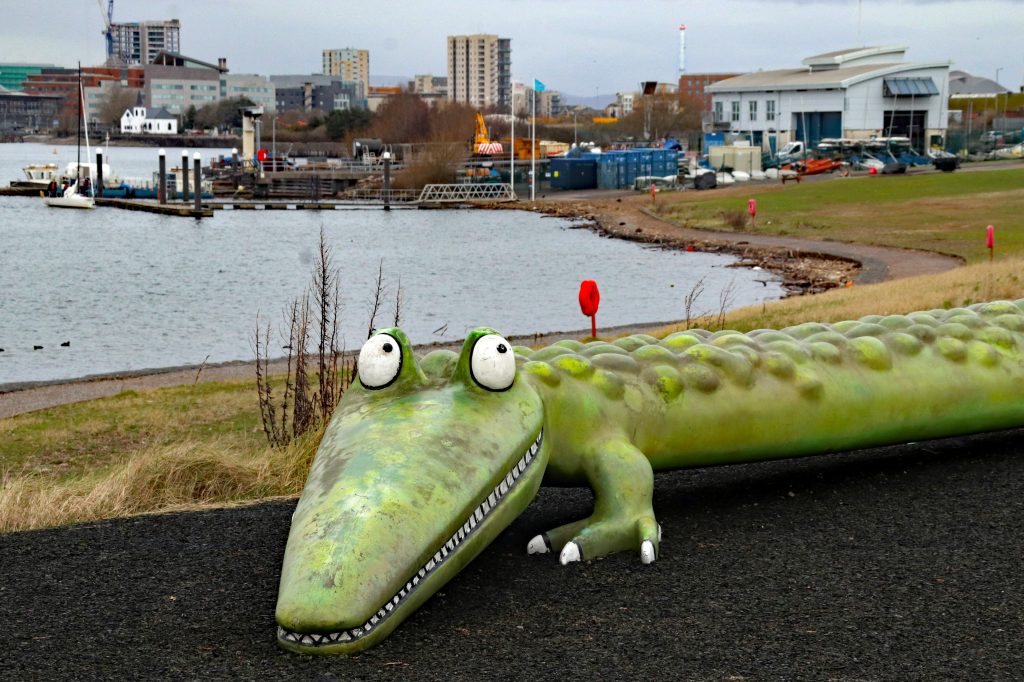
The enormous crocodile bench/ Croc in the Dock, homage to Roald Dahl
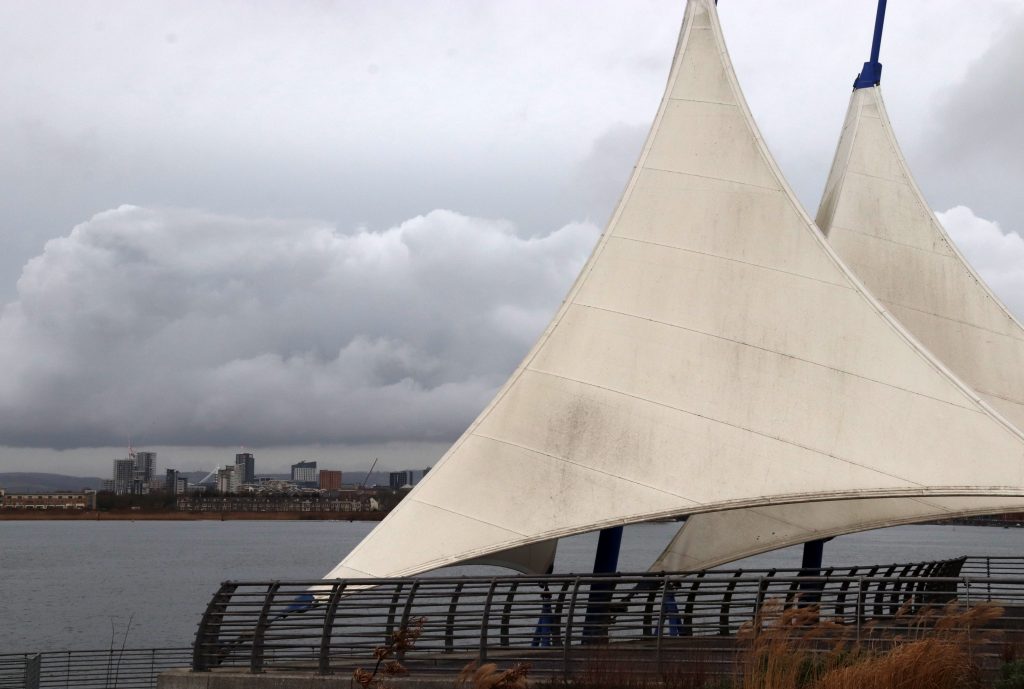
Mock white sails brighten up views across the bay

Exotic planting along the landscaped barrage

The barrage promenade
After a most welcome hot drink at the café by the barrage and a quick look at our very own SEP display board, I took the ‘most popular’ stretch of the Wales Coastal Path, along the barrage towards Mermaid Quay. Unlike most previous visits, it was eerily quiet: there was only the occasional dog walker, tourist and cyclist and, apart from a few dishevelled skateboarders, all the play areas were deserted. Against the dark grey forbidding sky the white sails on the barrage really stood out. Although these are supposedly a reminder of Cardiff’s historic sailing tradition, as I looked out across an empty Bay towards a relatively new skyline of apartment blocks and other high-rise buildings, I struggled to imagine the scores of vessels which must have waited outside Cardiff Docks here to load up with South Wales’ ‘gold’: high quality coal. It was also difficult to imagine the scene here immediately prior to the barrage’s construction when you’d have been standing in (rather sinking into!) a sea of undulating mudflats on the edge of the estuary. I do remember well, however, the tortuous debate relating to the demise of these muddy areas before the Cardiff Bay Barrage Act was finally passed: to some these areas were deemed ‘aesthetically unattractive’ but to others they were a haven for wildlife, having been declared a Site of Special Scientific Interest due to their important population of over-wintering birds. No doubt I’ll come back to discuss this further when I visit the Newport Wetlands site, part of the mitigation for the barrage’s impact, in a future walk.
On such a cold day it was difficult contemplating climate change. However, an information board drew my attention to Cardiff County’s first ‘Tiny Forest’ which has been planted to mitigate the effects of climate change. Currently, a somewhat unremarkable patch of saplings on the edge of the barrage, it is hoped this will become a dense native woodland of 1000 trees and will ‘support urban wildlife and reconnect people with nature’. Other attempts to attract wildlife include the landscaping along the barrage which incorporates plant species which can tolerate the demands of this highly exposed coastal environment and also attract key pollinators. Most noticeable was the tall ‘Flagship’ swift tower‘ which plays out quite loud (!) pre-recorded swift calls in an effort to attract swifts, now a red-listed species, to the artificial nest boxes. Penetrating the stillness of the Bay on my visit, I did wonder why the audio was still playing in early February given swifts are summer visitors. On reflection, however, I think the recording is powered by solar energy, which seemingly, even on a drab day in February, still works!
Reminders of Tiger Bay – challenges of urban waterfront regeneration
Descending from the barrage path, there is a short stretch of the Cardiff Bay Trail which my husband describes as the ‘bleak corner,’ where the trail takes you between a derelict old dry dock and the formidable high wire fence of the current port. These remaining pockets of decaying industrial heritage, with their mottled stone walls and rusting infrastructure, are a stark reminder of the immense challenge associated with the sheer scale of redevelopment here – after all nearly 13km of new waterfront were created by the impoundment. Whilst these areas have been recently described in the Welsh news media as ‘wasteland areas … starved of development’, I personally find such sections fascinating photo opportunities, offering rare glimpses of the gritty industrial past of Tiger Bay. However, less appealing were the piles of debris littering the shoreline and floating in some of the more inaccessible water areas – I counted a whole tournament’s worth of footballs and rugby balls bobbing around in a sea of plastic in just one corner of one old dry dock. However, after a succession of intense storms over the last few months, including Storm Bert and Storm Darragh, when I’ve seen whole tree trunks, fridge freezers and more speeding down the Taff, it was hardly surprising to see the volume of material which has collected here. This not only is a formidable clean-up task for the purpose-built Water Witch boats, but also an ecological hazard to shoreline birds. I was particularly saddened to see the poor heron which was camouflaged against the multi-coloured piles of rubbish – if you look carefully you may just see him in the photo below.
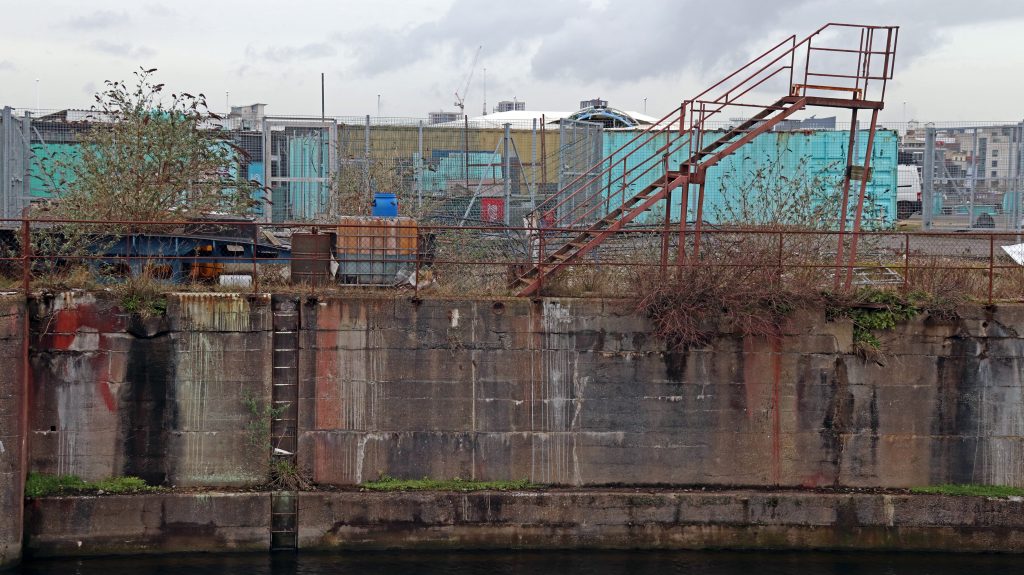
Quay walls of the old dry docks

Litter challenges – can you see the heron?
The classic urban waterfront
Continuing along the trail I crossed the ‘Origami-inspired’ bridge, pleasingly colourful on such a dull day. This unusual structure spans the Roath Basin. Looking like a gliding giant red kite, it is quite a contrast in shape and design to the rusting lock gates of the adjacent Roath Basin. Beyond this, the Norwegian Church Arts Centre with its brilliant white wooden cladding, seemed to welcome me to the next section of the waterfront – the spruced up ‘heart’ of Cardiff Bay with its many attractions, including Wales’ national art centre, the Millennium Centre, and The Roald Dahl Plass, a large plaza which hosts public outdoor events. With time no longer on my side, I had to forgo the delicious cakes on offer at the Norwegian Church. However, having many fond memories of family occasions and work events here, I should tell you a little more about this iconic building where Roald Dahl was baptised. Built in 1868, it provided a meeting place for Norwegian seafarers coming ashore from Norwegian ships, berthed in the docks. Interestingly, many of these ships were trading cheap timber from Scandinavian pine forests to service the south Wales coal fields. Having been moved from its original site, it’s now an important arts venue hosting an interesting variety of events and arts exhibitions. I’m certainly looking forward to hearing the Welsh folk string trio, Vri, perform here in a few weeks’ time.
Fortunately, the weather by now was improving so I could indulge myself in a few ‘classic’ photos of the waterfront. As you may appreciate from my photos, there’s an interesting interplay between the old and new here. In the muted afternoon sunshine the old wooden dolphins provided an interesting foreground to the contemporary skyline on the other side of the Bay, and the twenty first century Senedd Building, with its striking wide open glass and slate frontage, even complemented its neighbour, the late nineteenth century Pierhead Building, with its ornate red tiles and clock tower, our Welsh ‘Big Ben!’
As I wanted to get to the wetlands and back to the barrage before dusk, I’d only time for a quick diversion into Roald Dahl Plass to admire the imposing arched bronze roof of the Millennium Centre (or The Armadillo as locals call it), and to appreciate the scale of this plaza. Once the ‘Oval Basin’ and entrance to the old port of Cardiff, it is now completely remodelled with imposing concrete columns. Indeed, it’s attractive modern aesthetic/architecture might be considered the epitome of the ‘superlative maritime city’ envisioned by the Cardiff Bay Development Corporation back in the 1980s. However, I do find it somewhat disappointing that, compared with many other dockland redevelopments, only fragments of the maritime heritage remain here and you do have to look hard to find them. As David notes ‘our maritime history has faded from memory and the city turned its back on the docks and the estuary.’ However, in a discrete corner at the entrance to the Oval Basin I did notice an old water level gauge scored into the stone quayside. These must have been so useful to many a ship’s captain entering the old port. However, standing on the almost deserted concrete pathway, I struggled to contemplate the hustle and bustle of the docks in their heyday. In the late nineteenth and early twentieth century, Cardiff had been the largest coal port in the world – indeed the world’s first ever million-pound deal was struck nearby, in the Coal Exchange. No time to visit that today though, so I continued along the waterfront past a somewhat quieter than usual Mermaid Quay to the old graving docks, now home to Techniquest and some stylish and expensive-looking apartment blocks.
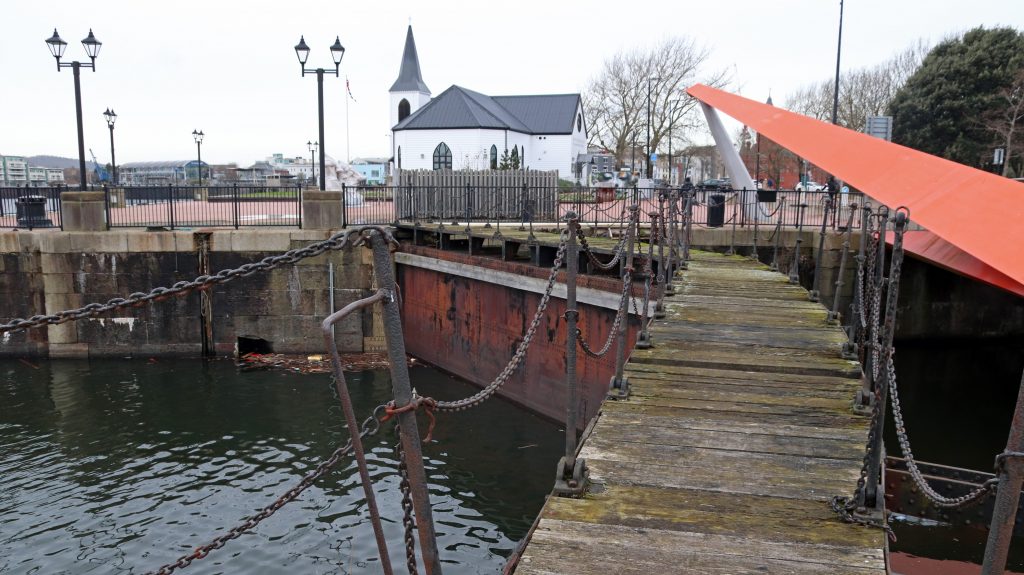
The old lock gates of Roath Basin with the Norwegian Church behind

The iconic wooden dolphins in Cardiff Bay

The Pierhead Building and the Senedd (the seat of Welsh Parliament, Senedd Cymru)

Water level gauge on quayside of the Oval Basin
A walk on the wilder side – Cardiff Bay Wetlands
Even on a relatively quiet day it was quite a contrast entering the Cardiff Bay Wetlands Reserve after seemingly miles of concrete waterfront. Apart from the distant hum of traffic, I really appreciated the relative tranquillity of this 8 hectare site as I wandered along the gravel walkways through the towering reed beds gently swaying in the light breeze. I was particularly enchanted by the elegant swans gracing the wetlands in front of the Windsor Esplanade and was thrilled to catch a few glimpses of other birdlife, including coots, grebes and Canada geese. I wasn’t lucky enough to see the Great Crested Grebes ‘exchanging courtship gifts of aquatic weed’ and ‘the stripe-headed offspring following their parents or even riding on their backs’ as described joyfully by Nerys, but today even the pigeons were keen to put on a display and pose for a photo! What a transformation has taken place over the years since I brought my first group of students to study this site. I must admit to having been rather sceptical about whether it would be possible to create a flourishing freshwater habitat here, particularly when it was replacing a saltmarsh prior to the barrage’s construction. However, thanks to the considerable efforts of the Cardiff Harbour Authority and others who’ve designed, maintained and enhanced this site, this new habitat really does support a rich diversity plant and animal species.

Wetlands in front of the Windsor Esplanade
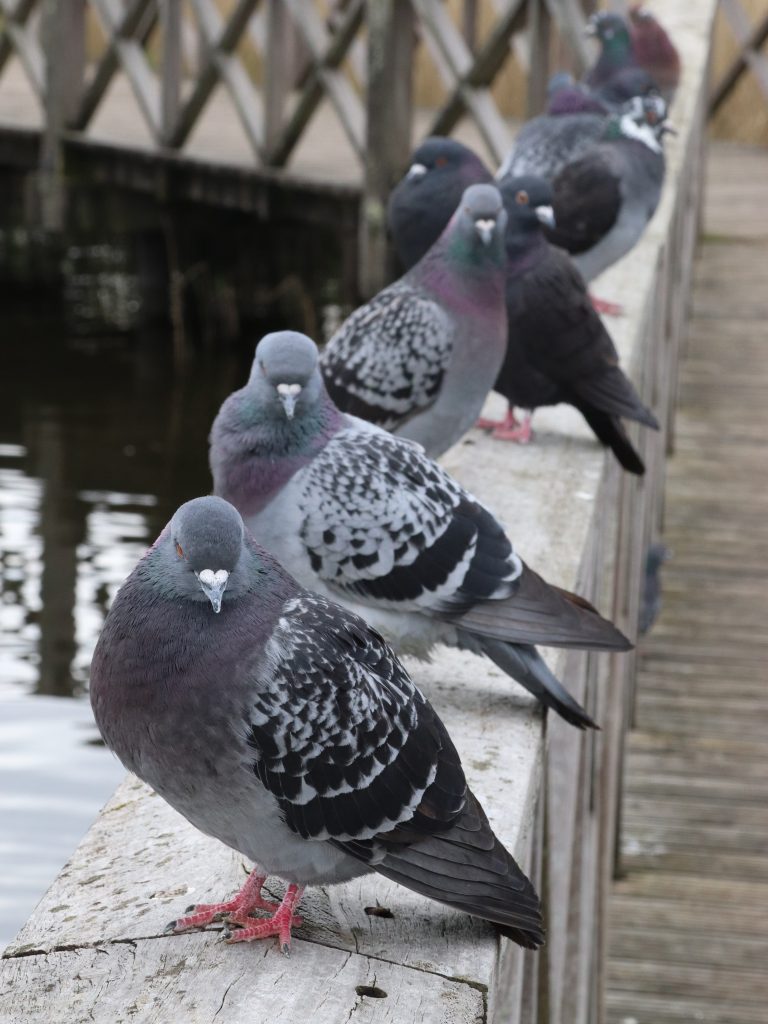
Pigeons posing on the fence by the walkway
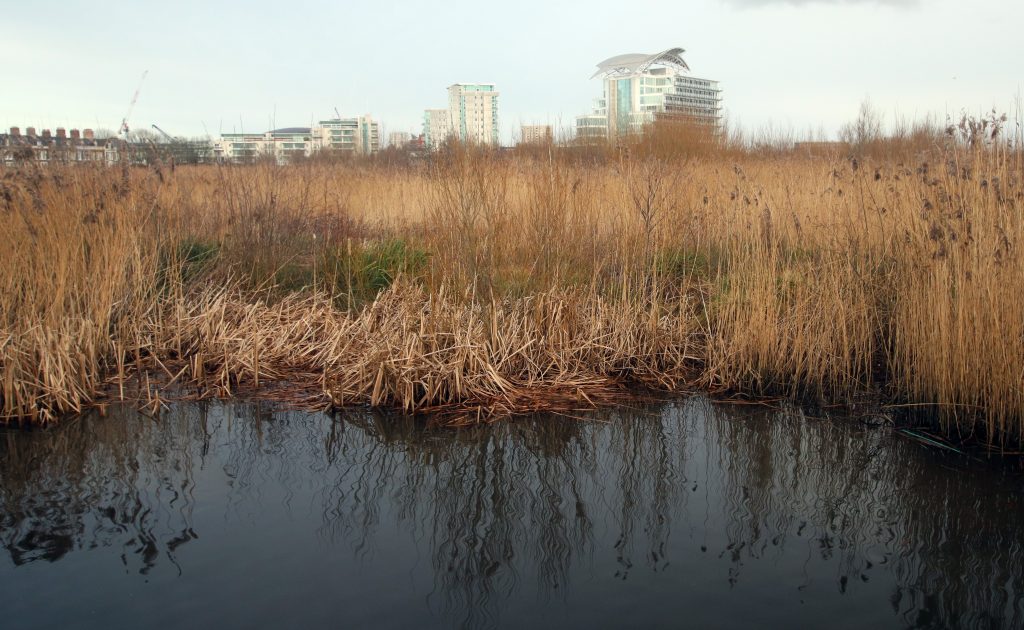
Reed beds in front of the voco St Davids Hotel
Final thoughts
On my return to the barrage, I admired the estuary as the early evening sun and the ebbing tide made for a few last photo opportunities. I agree with David ‘being able to stroll along the Barrage embankment with a large freshwater lake to one side and a huge, ecologically important estuary to the other is a unique experience.’ Tonight, for me the evening sky across the Bay was attractive, but what a beautiful and peaceful vista across the mud flats as the light began to fade. Today these were certainly not ‘unsightly’ mudflats, but, then again, I was only able to appreciate them from the viewing platform afforded by the barrage itself. How ironic. Perhaps the construction of the barrage really ‘was the beginning of when Cardiff learned to love its waterfront again’ as David suggests.

An offshore dolphin emerging from the estuary’s mudflats
On considering the future of this stretch of coast, I was hopeful that there’ll still be an attractive waterfront here in twenty or so years’ time and that we’ll still be able to admire the magic of the shimmering mudflats offshore at low water. There will be challenges, including climate change which particularly concerns Nerys, but hopefully environmental projects, such as the Tiny Forest, will flourish and help mitigate some impacts. In terms of Cardiff Bay, I’d tend to agree with David’s view that ‘the greatest challenge’ here ‘relates to balancing the demand for future development, whilst ensuring that it remains a peaceful and attractive place to visit.’ Given the number of new development proposals, even including re-redevelopment schemes at Atlantic Wharf, these will all have to be very carefully managed.
As I finished my walk, tired and rather peckish, I reflected on my day and on the wider lessons learnt from the urban development process here. All seems good now, but that’s only thanks to the intense scrutiny of potential environmental impacts in the 80s and 90s, the considerable expenditure to address these impacts and the ongoing efforts of the Cardiff Harbour Bay Authority. Questions remain over the compensation for lost environmental interest associated with the demise of the mudflats. Are there lessons here for other large scale estuary developments, I wonder?
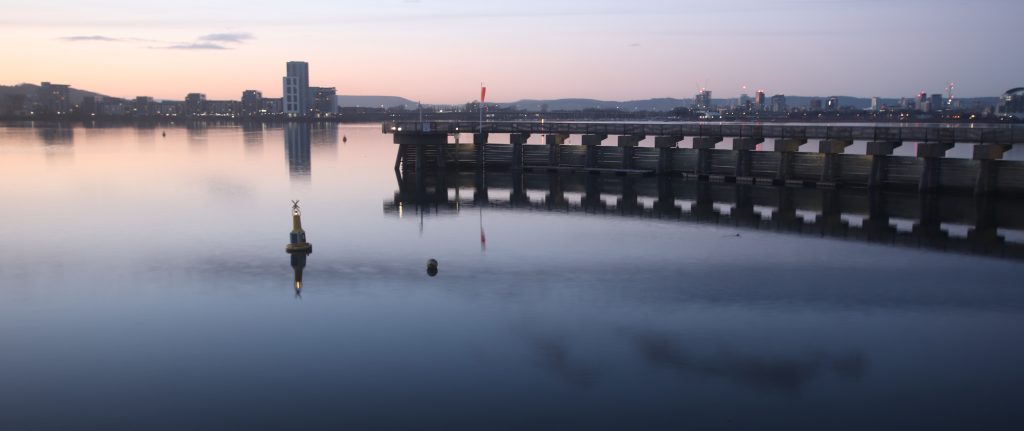
Sunset across Cardiff Bay
A few more interesting websites on Cardiff Bay and walks for you to try
Cardiff Bay – Cardiff Harbour Authority website

 Severn Estuary Partnership
Severn Estuary Partnership